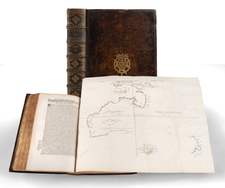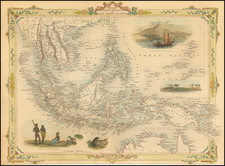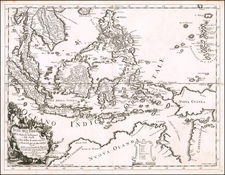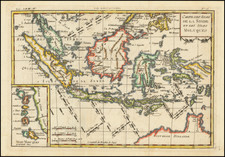A fine large-scale chart of Singapore Harbour, issued in 1892, depicting the city just before a period of dramatic growth.
This important chart focuses on what is now downtown Singapore and the immediate appraoches to the Singapore River and the Docklands at Keppel Harbour. The chart shows a detailed plan of the City, along with extensive soundings, shoals, topographical details and contiguous islands. The urbanized zone was then limited to relatively small areas on both sides of the mouth of the Singapore River, congregated around what is now the Central Business District, and then extending across towards what is now Rochor.
What is today Raffles Place is shown to be immediately on the shoreline of the Harbor at the mouth of the river, while Orchard Road was a country lane running past various farms and plantations (Emerald Hill is shown to be well outside of the town). While the entire island then had only about 185,000 inhabitants, Singapore already possessed outside importance as the primary base of the Royal Navy in East Asia and the capital of the Straits Settlements, Britain's colonial holdings on the Malay Peninsula. It was also a major commerical port, handling upwards of 2 million tons of goods annually.
Evident on the map are the beginnings of major infrastructure programs that would foster a dramatic expansion in Singapore's economy, and population. Shown leading into the city from the north is the newly-built Singapore Government Railway, which was connected the city to the Malay Peninsula (via ferry to Johor). As indicated, the line would shortly be extended to reach Tanjong Pagar and the docklands at Keppel. Also evident are the first of many land reclamation projects which would greatly expand the acreage of both downtown and the harbour district. The Telok Ayer Reclamation is shown to add land to the downwtown area, while Tanjong Pagar Land Company (TPL Co.) has already commenced what would be a massive extension of the docklands.
This chart would have been quite important during its time as the definitive pilot chart for guiding ships into Singapore Harbor. The present example is exceptional, in that it survives in very fine condition, as most charts of this kind suffered due to heavy use at sea. It is also a fascinating record of the city's development during the late Victorian era.
The British Admiralty has produced nautical charts since 1795 under the auspices of the United Kingdom Hydrographic Office (HO). Its main task was to provide the Royal Navy with navigational products and service, but since 1821 it has also sold charts to the public.
In 1795, King George III appointed Alexander Dalrymple, a pedantic geographer, to consolidate, catalogue, and improve the Royal Navy’s charts. He produced the first chart as the Hydrographer to the Admiralty in 1802. Dalrymple, known for his sticky personality, served until his death in 1808, when he was succeeded by Captain Thomas Hurd. The HO has been run by naval officers ever since.
Hurd professionalized the office and increased its efficiency. He was succeeded by the Arctic explorer Captain William Parry in 1823. By 1825, the HO was offering over seven hundred charts and views for sale. Under Parry, the HO also began to participate in exploratory expeditions. The first was a joint French-Spanish-British trip to the South Atlantic, a voyage organized in part by the Royal Society of London.
In 1829, Rear-Admiral Sir Francis Beaufort was appointed Hydrographer Royal. Under his management, the HO introduced the wind force scale named for him, as well as began issuing official tide tables (1833). It was under Beaufort that HMS Beagle completed several surveying missions, including its most famous voyage commanded by Captain FitzRoy with Charles Darwin onboard. When Beaufort retired in 1855, the HO had nearly two thousand charts in its catalog.
Later in the nineteenth century, the HO supported the Challenger expedition, which is credited with helping to found the discipline of oceanography. The HO participated in the International Meridian Conference which decided on the Greenwich Meridian as the Prime Meridian. Regulation and standardization of oceanic and navigational measures continued into the twentieth century, with the HO participating at the first International Hydrographic Organization meeting in 1921.
During World War II, the HO chart making facility moved to Taunton, the first purpose-built building it ever inhabited. In 1953, the first purpose-built survey ship went to sea, the HMS Vidal. Today, there is an entire class of survey vessels that make up the Royal Navy’s Hydrographic Squadron. The HO began to computerize their charts in the late 1960s and early 1970s. In 1968, the compilation staff also came to Taunton, and the HO continues to work from there today.









![(Southeast Asia) [Unpublished Manuscript Sailing Directions from Europe to China by a French Navigational Officer]](https://storage.googleapis.com/raremaps/img/small/90507.jpg)




